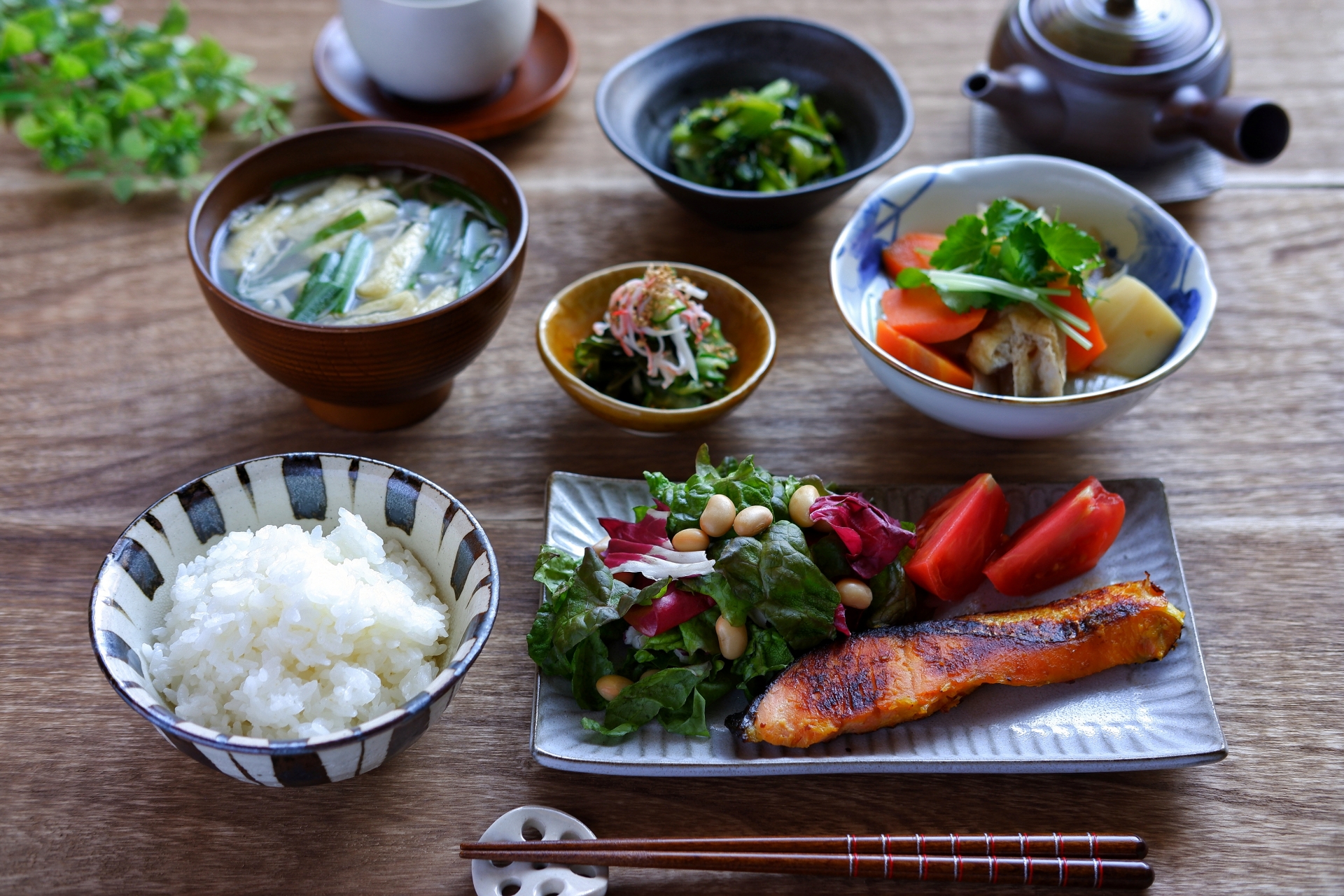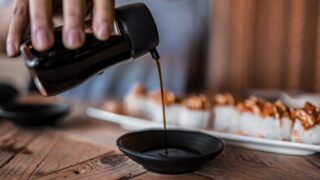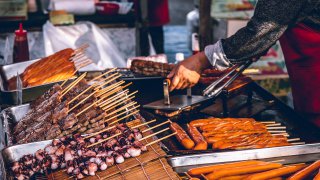When asked about what they like best about Japan, many (internationals) will mention the food as their top three reasons. Japanese sushi and ramen are world-famous, but there is much more to discover than just these two, just think of all the different types of noodles and vegetables. Because Japan is an island country, it has developed a unique food culture with a range of ingredients produced within the country.
Recently, Japanese food is getting more and more popular as a healthy cuisine with the number of Japanese restaurants around the world expanding rapidly. While there are traditional Japanese dishes that have been loved for over centuries, some modern recipes were created with influence from Western world, especially after Japan opened its borders after two decades of isolation known as the Sakoku policy (1633 -1853). They are probably easy to try to make even for foreigners as some of them are similar to what they have back in their home country. The best way to discover all the yummy Japanese food is of course trying it in Japan, for example in Nishiki Market in Kyoto or Tsukiji Market in Tokyo, but it is also possible to prepare some of the Japanese dishes yourself at home! Here is a list of 15 typical meals in Japan that you can easily make at home!
- 1. Onigiri (おにぎり)
- 2. Miso soup (みそ汁)
- 3. Nikujaga (肉じゃが)
- 4. Curry Rice (カレーライス)
- 5. Omurice (オムライス)
- 6. Takikomi Gohan (炊き込みご飯)
- 7. Tamagoyaki (卵焼き)
- 8. Shogayaki (生姜焼き)
- 9. Karaage (からあげ)
- 10. Yakizakana (焼き魚)
- 11. Hambagu (ハンバーグ)
- 12. Oyakodon (親子丼)
- 13. Udon / Soba (うどん/そば)
- 14. Chirashizushi (ちらし寿司)
- 15. Tonkatsu (とんかつ)
- Enjoy Japanese cooking experiences
- Other articles you might like
1. Onigiri (おにぎり)
Onigiri is basically a rice ball wrapped in black seaweed. It is one of the most popular snacks, sold at every supermarkt and every konbini! The most famous traditional Japanese dishes are relatively easy to make and usually contain some salt and ingredients or filings in the rice balls, such as grilled salmon, pickled plum, or spicy cod roe. When you hear the word onigiri and riceball, you might imagine a round-shaped snack, but in reality the rice balls come in all kinds of shapes and flavours. If you go to a convenience store in Japan, you will find a large selection of onigiri mostly shaped like a triangle. What’s even better is that they are reasonably priced, like many other fresh konbini snacks, making it a perfect option as your first food experience when you are visiting Japan and once you have tried some onigiri you’ll want to try to make your own at home!
Onigiri Recipe
Ingredients:
- Cooked rice
- Nori (dried seaweed)
- Any fillings you want (grilled salmon, tuna flakes with mayonnaise and pickled plum)
- Wet your hand and sprinkle salt over the hand
- Put handful of cooked rice in one hand
- Put the fillings at the center and gently push them into the rice
- Use both hands to press and squeeze lightly to make a triangle shape
- Wrap the onigiri with a slice of nori
▶Take a cooking class to learn how to make onigiri and other meals!
2. Miso soup (みそ汁)
Miso soup is a traditional Japanese soup made from miso paste, dashi (broth). Next to the broth and miso paste, there are often some additional ingredients such as vegetables, seaweed, and tofu. Miso soup is often served as a part of Japanese-style meals along with white rice and grilled fish. The brown soup might look unfamiliar for those who have never tried it before, but the gentle taste can be everyone’s favorite regardless of your heritage, nationality or age! If you get an opportunity to stay at a traditional Japanese ryokan, it is probably served for breakfast, to warm your body from inside and start the day smoothly!
Miso Soup Recipe
Ingredients:
- Miso
- Dashi (kombu, dried kelp or katsuobushi, dried bonito)
- Ingredients of your choice (scallion, tofu, seaweed etc)
- Make dashi stock (you can also use dashi packet or powder with water)
- Boil dashi stock and put the vegetables/seaweed
- Put the miso into the ladle, and slowly add it into the dash to dissolve. Use a small whisk to dissolve miso quickly if you have it
- Add tofu
3. Nikujaga (肉じゃが)
Nikujaga is a unique, homemade meal that has been enjoyed by Japanese people over the years. It can be translated as “braised meat and potatoes” in English. Typical ingredients for Nikujaga include pork, potatoes, carrots, onions and konnyaku noodles. They are stewed with sweetened soy sauce until all the ingredients get soft. You can enjoy a rich variety of taste and texture just in one dish.
Nikujaga Recipe
Ingredients:
- Vegetables (potatoes, carrots, onions)
- Sliced pork
- Soy sauce, sake, sugar, mirin, dashi
- Water
- Cut the vegetables
- Cook and stir beef
- When the beef turned brown, add vegetables
- Add sugar and water
- Add soy sauce, sake, mirin and dashi and then simmer for 20-30 minutes
▶Learn how to cook nikujaga from locals!
4. Curry Rice (カレーライス)
Curry Rice literally means a plate of curry and rice, and unsurprisingly the dish is generally served and enjoyed on one plate. Curry was originally introduced from India to Japan in the late 19th century, and the recipe has been adapted over centuries. The curry sauce is made with a range of ingredients such as potatoes, carrots, onions and beef. The spicy taste can easily be made with curry powder or roux sold at every supermarket. You can choose the preferred spicy level from different spicinesses, including mild ones with an almost sweet flavor which is always a favorite among little children!
Curry Rice Recipe
Ingredients:
- Vegetables (potatoes, carrots, onions)
- Sliced pork or beef, or chicken
- Curry roux (if it’s not available, check this recipe to make from scratch)
- Water
- Cook and stir onions > potatoes and carrots > meats
- Add water and boil for 15 minutes
- Add curry roux and simmer for 10 minutes
▶Learn how to cook the best curry with an online class
5. Omurice (オムライス)
Omurice is a Japanese coined word that consists of “omu” (omelet) and “rice”. The appearance might look like a Western-style dish, but it was actually invented by a Japanese chef in the 19th century! It is basically an omelet stuffed with fried rice cooked with chicken and ketchup. You can use bacon as a substitute for chicken or add some other ingredients such as butter, onions and carrots when frying the rice!
Omurice Recipe
Ingredients:
- Eggs
- Cooked rice
- Ketchup
- Chicken
- Onions
- Butter
- Cook and stir onions and chicken
- Add cooked rice
- Add ketchup and stir, then serve on the plate
- Add butter on the frying pan
- Beat the eggs and add them into the frying pan
- Put the omelet onto the rice
- Decorate the top with ketchup!
▶Take an online class and cook delicious omurice at home!
6. Takikomi Gohan (炊き込みご飯)
Takikomi Gohan is a Japanese mixed rice with a variety of ingredients. It is often made on special occasions such as celebrations or traditional parties. It consists of seasoned rice and typical ingredients such as chicken, carrots, burdock and shiitake mushrooms. If you are bored with plain white rice and want to try Takikomi Gohan at home, you can put all the ingredients and seasoning in a rice cooker and cook them all together! There are tons of recipes available online or in cookbooks to make the delicate taste on your own.
Takikomi Gohan Recipe
Ingredients:
- Rice
- Chicken
- Dried shiitake mushrooms
- Carrot
- Burdock
- Konnyaku
- Abura-age (fried tofu pouch)
- Dashi stock, say sauce and mirin
- Soak dried shiitake in the water for a couple of hours (don’t throw away this water after the shiitake is done, you will use this water as dashi)
- Rinse the rice and leave for an hour in the water then drain
- Cut the ingredients
- Add stock from shiitake, soy sauce, mirin and dashi stock
- Add ingredients and cook rice
▶Let’s cook takikomi gohan with a traditional wood-fired rice cooker!
7. Tamagoyaki (卵焼き)
Tamagoyaki is a Japanese rolled omelet that is often seasoned with salt and soy sauce. It is slightly different from what is thought of as an omelet in other countries; the most notable feature is a unique shape which consists of layers of eggs. This omelet is super popular in Japan and you will often see it on the menu at sushi restaurants or sometimes even freshly prepared at markets. In our Tsukiji Food & Drink Tour you will also see how the omelet is made and try some fresh tamagoyaki yourself! The original recipe doesn’t require any ingredients in it except seasoning and enjoy the simple taste. You can also make a sweet one with sugar, which is always popular as a side dish in lunch boxes for children in Japan.

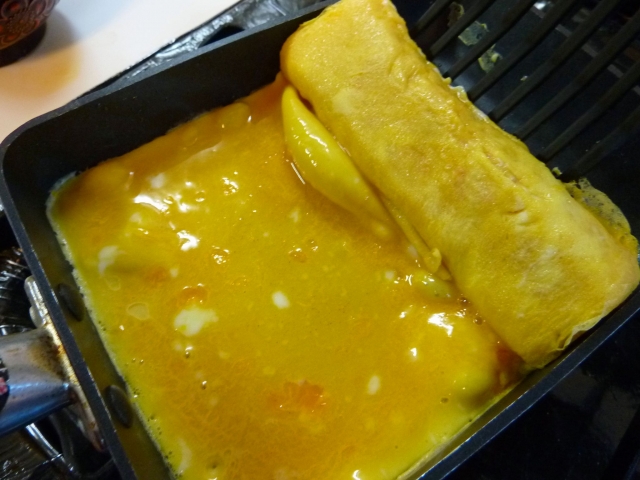
Tamagoyaki Recipe
Ingredients:
- Eggs
- Dashi
- Salt
- Add eggs, dashi and salt and whisk in the bowl
- Put the oil into the pan
- Put 2/3 of 1 egg and when the small bubbles appear, poke the bubble to release the air
- When the egg half cooked, roll the egg to the side
- Add the oil and then add little 1 egg again, and roll the egg to the side and repeat the process
▶It might be a bit difficult to make clean-shaped tamagoyaki first. Do you want to learn some tips? Take a cooking class!
8. Shogayaki (生姜焼き)
Shogayaki is a popular Japanese dish which can be described as grilled/fried (yaki) pork with ginger (shoga). It is one of the most common pork dishes to be made at home and also Japanese salarymen’s one of the most popular dishes, right after tonkatsu. Shogayaki consists of sliced pork and grated ginger, grilled with sliced onions. The typical seasoning is soy sauce, cooking sake and mirin (another type of sweet cooking sake). Compared to other meat dishes such as karaage and tonkatsu, it is relatively easy to make in a short time, even for beginners!
Shogayaki Recipe
Ingredients:
- Sliced pork
- Grated ginger
- Soy sauce
- Sugar
- Sake
- Mirin
- Sesame oil
- Mix grated ginger, soy sauce, sugar, sake and mirin to make tare (sauce)
- Put the sesami oil into the pan and cook the pork
- Add tare then stir and fry
▶Learn more about one of the most popular home-cooking meals!
9. Karaage (からあげ)
Karaage is a deep fried dish where meat or vegetables are coated in potato starch and deep fried until crisps. Various foods can be used, but fried chicken is definitely the most popular in Japan. The standard word for Japanese fried chicken, as it’s become known around the world, is karaage and nine out of ten times you will get chicken when ordering karaage in a restaurant. Unlike fried chicken eaten in other countries, karaage is a bite-sized, usually boneless chicken with a crispy texture and the flavorful garlic smell that is hard to resist! Karaage is also eaten cold in bento boxes – the popular Japanese lunch boxes.
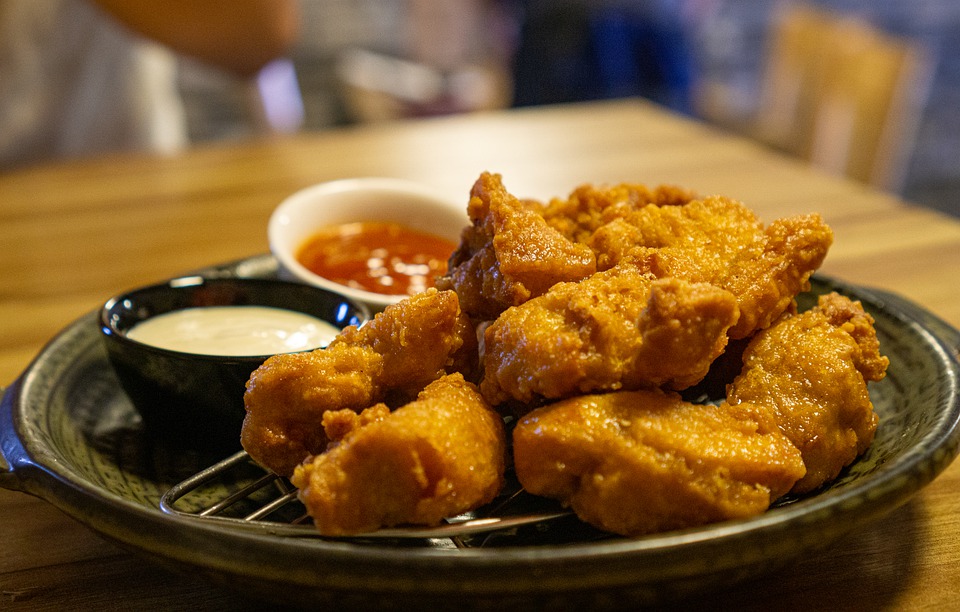
Karaage Recipe
Ingredients:
- Boneless chicken thighs
- Soy sauce
- Sake
- Grated garlic
- Grated ginger
- Potato starch
- Chop the chicken thighs into the bite-size
- Mix soy sauce, sake, grated garlic and ginger and marinate the chicken for 20-30 minutes
- Coat the chicken with potato starch
- Prepare the oil to 170℃
- Fry 3-4 pieces of chicken until they turn the color to brown
▶Cook karaage and onigiri at local’s home
10. Yakizakana (焼き魚)
Yakizakana refers to grilled fish, often one of the essential elements for traditional Japanese-style meals which are often served in Japanese ryokans. Almost any kind of fish can be used for yakizakana but salmon is the most popular one which adds a bright orange color to the table. The recipe is too simple to mention: just grill the fish until it gets completely cooked! It is best to season the fish with salt and pepper beforehand, and start to grill with the side of skin!
Yakizakana Recipe
Ingredients:
- Fillet of fish of your choice
- Sault
- Rinse the fish and drain off water
- Slash the fish
- Preheat the oven to 250℃
- Heat for 15-20 minutes
▶Learn how to cook Japanese typical meals including grilled fish, miso soup and more!
11. Hambagu (ハンバーグ)
In Japan, you can find two very similar-sounding dishes that are both quite popular: hambagu and hambaga. An hambaga refers to the American-style hamburger and is logically seen as a foreign dish in Japan. Hambagu refers to a popular Japanese dish similar to Hamburg steak in Western countries. It is made from ground meat, chopped onions, eggs and breadcrumbs seasoned with salt and pepper. Mix them carefully in a bowl and form them into patties. Hambagu is usually served with rice or bread, as well as steamed or grilled vegetables or mashed potatoes on the side.
Hambagu Recipe
Ingredients:
- Ground pork/beef
- Onions
- Panko
- Milk
- Salt and pepper
- Nutmeg
- Egg
- Sauce of your choice (teriyaki or demi-glace sauce)
- Cook chopped onions
- Knead the ground pork/beef
- Add salt, pepper and nutmeg and then knead more
- Add 1 (cooked onions), panko soaked in milk, egg and knead
- Make round shape
- Put the oil into the pan and put 5
- Cook each side for about 3 minutes
- Put on the lid and steam for 5 minutes
- Serve with sauce
▶Learn how to make delicious hambagu at home!
12. Oyakodon (親子丼)
The super popular soul food of Japan, oyakodon is a chicken and egg rice bowl. Oyako (親子) means parent and child, and don (丼) means a bowl, so it is referred to a parent-and-child-rice-bowl. The bowl has bit-sized chicken pieces and soft-cooked eggs as the main ingredients, cooked with sliced onions and soy sauce-based broth soup. Oyakodon is served with white rice in a bowl. The recipe is easy to make for everyone, using basic ingredients. You can also try oyakodon at many restaurants or famous Gyudon (牛丼) chain restaurants.
Oyakodon Recipe
Ingredients:
- Chicken thigh
- Onion
- Eggs
- Water
- Dashi powder
- Sugar
- Soy sauce
- Mirin
- Cooked rice
- Cut the chicken thigh into bite-size and slice the onion
- Add water, dashi powder, sugar, soy sauce and mirin into the pan
- After it boiled, add chicken and sliced onions, simmer for a couple of minutes
- Add beaten egg and stir
- When the egg gets half-done, serve them on the cooked rice
▶Book a cooking class to make oyakodon in Hyogo!
13. Udon / Soba (うどん/そば)
You have probably heard of Udon and Soba noodles, the super popular Japanese noodles which have been loved for over centuries. Japanese noodles are used in numerous dishes in Japan. Udon is a white, flour noodle which is generally thicker than soba (also known as buckwheat noodles). Their history is said to date back at least to the Edo period, and have long been a favourite of Japanese people. They rapidly became popular because of the affordable price and easy recipes. Recently soba noodles have gained attention for its health benefits, the healthy food is a popular diet food and known for energy-storing properties. Both noodles are eaten throughout the year, and on New Year’s Eve Japanese people usually have either of them to celebrate the arrival of new year and to hope for a long life like their long shape!
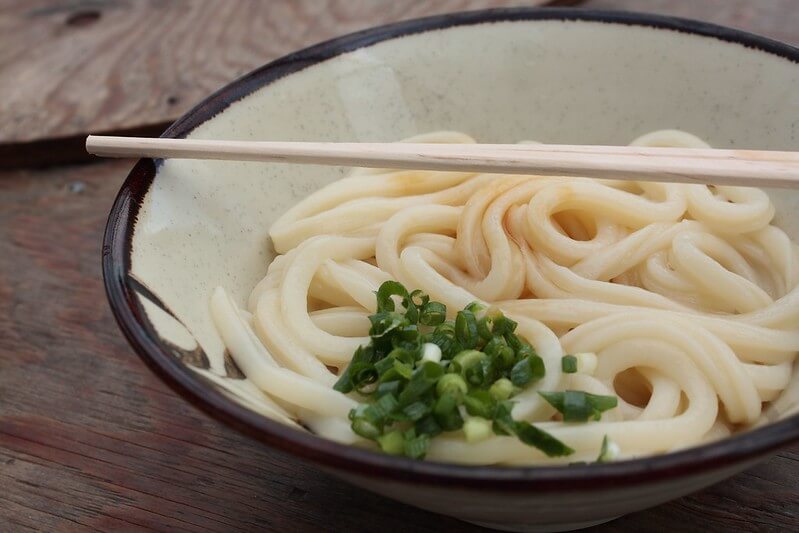

Udon/ Soba Recipe
Ingredients:
- Udon or soba noodles
- Toppings of your choice
- Water
- Katsuobushi
- Mirin
- Soy sauce
- Make boiling water and then stop the heat, add katsuobushi
- After katsuobushi sink to the bottom, strain katsuobushi
- Put 2, mirin, soy sauce into the pot
- When it’s boiled, simmer for 2 minutes on low heat
- Serve with udon or soba noodles
▶Let’s cook udon from scratch at your home (online cooking class)
14. Chirashizushi (ちらし寿司)
Chirashizushi is a unique type of sushi topped with colorful ingredients. It is generally eaten on March 3rd known as Girl’s Day or Hinamatsuri – one of Japan’s many national holidays – to celebrate healthy growth of girls. Typical toppings include sashimi, boiled shrimps, shiitake mushrooms, eggs, and vegetables. The exact toppings might vary depending on the region or household preferences, but they are usually laid on top on vinegared rice. The beautiful appearance with colorful toppings is perfect as a special dish for the spring season!
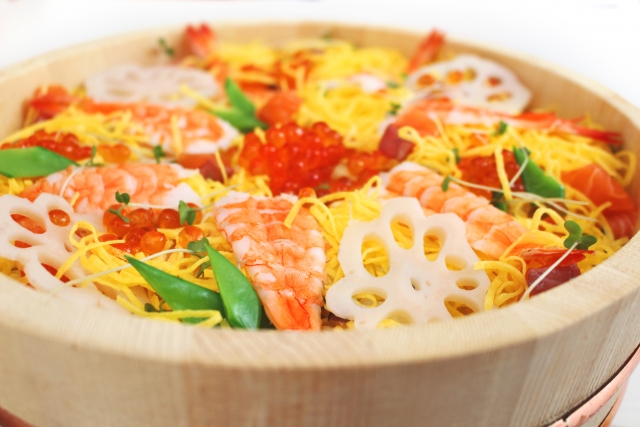
Chirashizushi Recipe
Ingredients:
- Cooked rice
- Rice vinegar
- Sugar
- Salt
- Vegetables (carrot, lotus root etc)
- Dried shiitake
- Egg
- Sake
- Soy sauce
- Soak dried shiitake in the water for a couple of hours (don’t throw away this water after the shiitake is done, you will use this water as dashi)
- Put the cooked rice into the big bowl and add rice vinegar, sugar and salt then mix the rice lightly (mix like “cutting”)
- Cool down the rice with fan then leave
- Cut the vegetables
- Put dashi water from shiitake, sugar, sake and soy sauce into the pan and boil
- Add shiitake and vegetables, stir and fry until water is gone
- Make thin omelet and slice into long and thin pieces
- Squeeze ingredients of 6 and add into 3 and mix
- Serve on the plate and scatter 7
▶Let’s learn how to make chirashizushi at home!
15. Tonkatsu (とんかつ)
Tonkatsu is a Japanese-style pork cutlet and is loved by the Japanese as one of the most popular meat dishes. It is basically a deep-fried pork cutlet made from thick pork breaded with flour and bread crumbs resulting in a crispy texture. There are a variety of dishes featuring tonkatsu such as Katsu-don (かつ丼), a bowl of rice topped with tonkatsu and egg! Be careful not to order tonkotsu instead, this is a completely different dish – a soup broth made of pork bones.
Tonkatsu Recipe
Ingredients:
- Thick sliced pork loin
- Salt and pepper
- Egg
- Flour
- Panko
- Lightly hit the meat and add salt and pepper
- Cover with flour, dip into the beaten egg and cover with panko
- Fry in 180 ℃ of oil until it turns brown
▶Let’s make tonkatsu with a local mother in Tokyo!
Enjoy Japanese cooking experiences
Did you get an appetite for Japanese food but looking for some help preparing these dishes? We have some options to get you started:
An amazing cookbook with basic but authentic Japanese recipes is Just One Cookbook. The recipes in this book are delicious and super easy to follow.
The second option is joining a cooking workshop, like these ones:
- Fun&Delicious!Online Fluffy Omu-Rice class
- Online class: Katsu Curry Japanese curry rice / Japanese food
- Tempura, Handmade Udon and Dashimakitamago(Japanese Rolled Omelet)
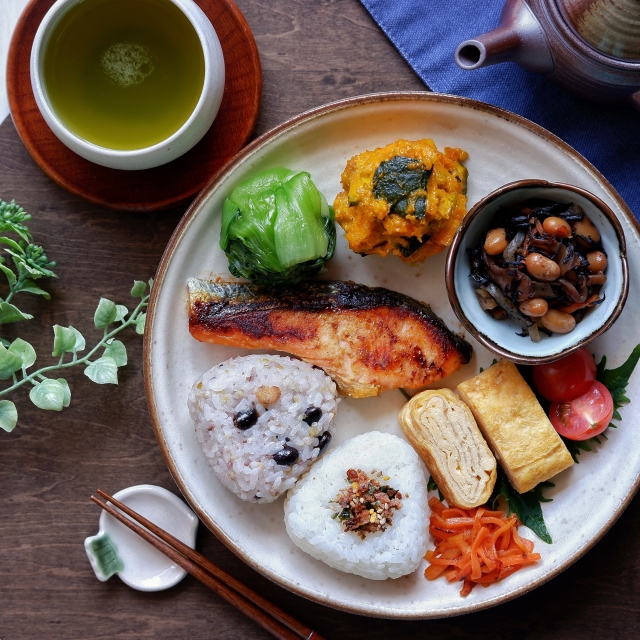
The last option, which is also the best way to learn everything there is about the Japanese cuisine and food culture is joining an actual tour in Japan. We have several fun food tours where you will go around exploring the Japanese produce and try them out.
Tokyo Fish Market Tour @Tsukiji
Explore the most lively & popular fish market in Tokyo to try fresh seafood and refreshing drinks with our friendly guide! There is also an option to combine a visit to Tsukiji market with a sushi-making workshop

Food & Drink Tour at Nishiki Market in Kyoto
Explore ‘Kyoto’s Kitchen’ where over 130 food shops and stalls will beckon your taste buds.
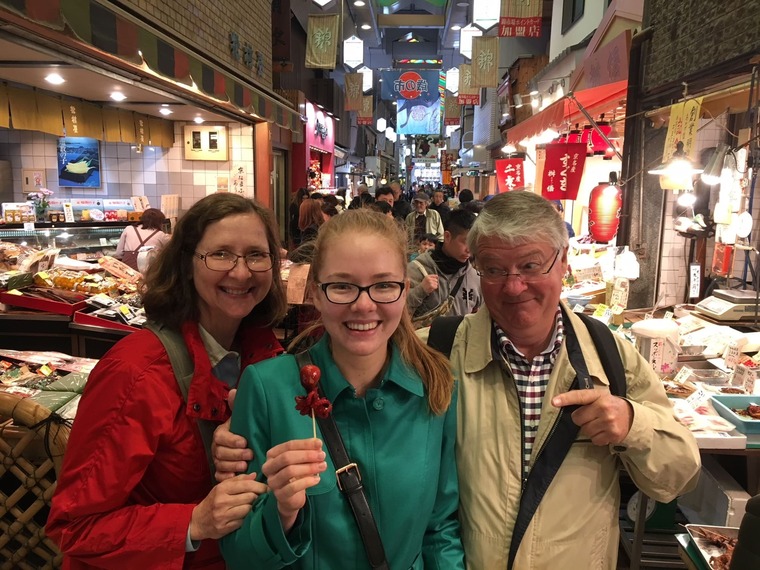
While there are high-class, professional Japanese dishes which are difficult to make on your own at home, all the dishes introduced above are casual and perfect for home cooking. You can probably get ingredients at supermarkets selling imported Japanese products in your country or use locally produced ingredients and cook these tasty dishes. If you are planning to visit, or staying in Japan, it is another option to join enjoyable cooking lessons in person! It will enable you to steal cooking skills from professional chefs while learning about the history of each dish!
Follow us on Instagram, Facebook and Twitter for more travel inspiration. Or tag us to get featured!
Happy traveling!
Stay informed of the best travel tips to Japan, the most exciting things to do and see, and the top experiences to have with the Japan Wonder Travel Newsletter. Once every two weeks we will introduce you to our latest content.
Other articles you might like

Miho Shimizu is a Japanese freelance writer settled in Shizuoka with her husband and two rabbits. Fascinated with travelling at the age of 18, she has spent most of her long holidays exploring incredible spots around Japan. Also love to listen to music, draw, and read novels over a cup of green tea.
This post may contain some affiliate links. When you click through and make a purchase we may receive some commission, at no extra costs to you.
